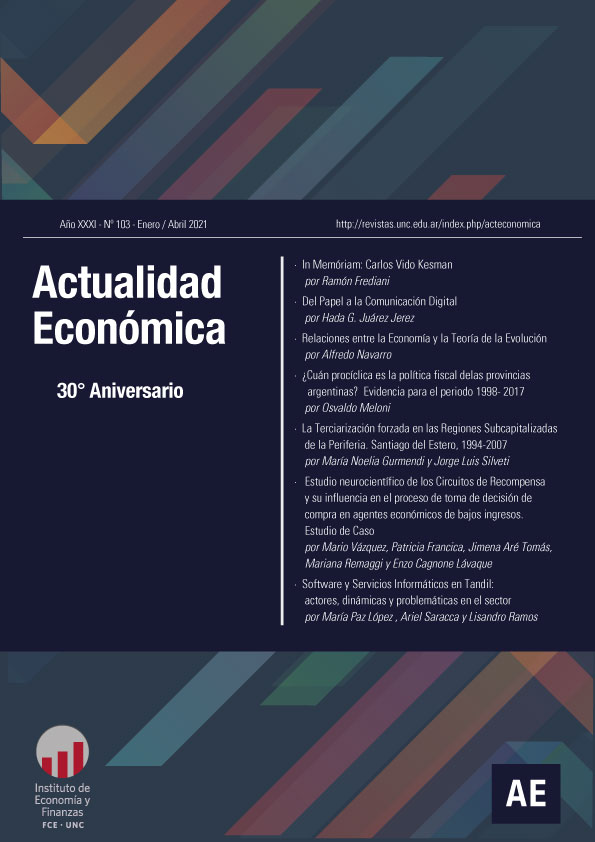¿Cuán procíclica es la política fiscal de las provincias argentinas? Evidencia para el periodo 1998- 2017
Palabras clave:
política fiscal, prociclicidad, ArgentinaResumen
Este trabajo proporciona evidencia sobre la prociclidad de política fiscal de los distritos subnacionales argentinos. Estimo un modelo de corrección de errores utilizando un panel que abarca 20 años (1998 – 2017) y los 24 distritos. Encuentro que la política fiscal de las jurisdicciones subnacionales es procíclica en todas las grandes categorías de gasto público y también en todos los rubros más importantes de los ingresos fiscales a excepción de las transferencias automáticas, que no tienen significación estadística. La respuesta del gasto al crecimiento contemporáneo en el nivel de actividad es mayor que la estimada por Meloni (2018) para el lapso 1985-2007, similar a la obtenida por Abbott et al. (2015) para los estados mejicanos y un poco menor a la encontrada por Arena y Revilla (2009) para los estados brasileños. Mis estimaciones también confirman que los recursos totales son procíclicos siendo las transferencias discrecionales el rubro con mayor grado de prociclidadad.
Descargas
Referencias
Abbott, A. and Jones, P. (2012). “Intergovernmental transfers and procyclical public spending.” Economics Letters 115: 447-451.
Abbott, A., Cabral, R., Jones, P. and Palacio, R. (2015). “Political pressure and procyclical expenditure: An analysis of the expenditures of state governments in Mexico.” European Journal of Political Economy 37: 195–206
Alesina, A., Campante, F. and Tabellini, G. (2008). “Why is fiscal policy often procyclical?” Journal of the European Economic Association, September 6(5):1006–1036
Akitoby, B., Clements, B., Gupta, S. and Inchauste, G. (2006). “Public spending, voracity, and Wagner’s law in developing countries.” European Journal of Political Economy, 22: 908-924.
Arena, M. and Revilla, J. (2009). “Pro-cyclical Fiscal Policy in Brazil. Evidence from the States.” Policy Research Working Paper 5144. The World Bank.
Barro, R. (1979). “On the Determination of the Public Debt.” Journal of Political Economy 87 (5); 940-71. Part 1, October.
Blundell, R. and Bond, S. (1998) “Initial conditions and moment restrictions in dynamic panel data models”. Journal of Econometrics 87 (1): 115-143.
Brückner, M. and Gradstein, M. (2014). “Government spending cyclicality: Evidence from transitory and persistent shocks in developing countries.” Journal of Development Economics, 111 107–116
Catão, L. and Sutton, B. (2002). “Sovereign Defaults: The Role of Volatility.” IMF Working Papers 02/149, International Monetary Fund.
Cukierman, A., Edwards, S. and Tabellini, G. (1992). “Seigniorage and Political Instability.” American Economic Review 82: 537-55.
Frankel, J. and Schreger, J. (2013) “Over-optimistic official forecasts and fiscal rules in the eurozone,” Review of World Economics, 2013, 149 (2), 247–272.
Frankel, J. and Schreger, J. (2016) “Bias in official fiscal forecasts: can private forecasts help?” NBER, Working Paper 22349.
Gavin, M. and Perotti, R. (1997). “Fiscal policy in Latin America.” NBER Macroeconomics Annual, 12: 11–61.
Jones, M., Meloni, O. and Tommasi, M. (2012). “Voters as Fiscal Liberals: Incentives and accountability in federal systems.” Economics and Politics. Vol. 24(2): 135-156.
Lane, P. and Tornell, A. (1996). “Power, growth and the voracity effect.” Journal of Economic Growth. 1(2):213–241.
Kaminski, G., Reinhart, C. and Vegh, C. (2004). “When it rains, it pours.” In: Gertler, Mark, Rogoff, Kenneth (Eds.), NBER Macroeconomics Annual. MIT Press, Cambridge, United States.
Meloni, O. (2016). “Electoral opportunism and vertical fiscal imbalance.” Journal of Applied Economics. 19(1).
Meloni, O. (2018) “Turning a Blind Eye to Policy Prescriptions: Exploring the Sources of Procyclical Fiscal Behavior at the Subnational Level” Public Finance and Management, 18(3-4): 265-284.
Rodden, J. and Wibbels, E. (2010) “Fiscal decentralization and the business cycle: an empirical sty of seven federations”. Economics and Politics, 22(1):37-67.
Sturzenegger, F. and Werneck, R. (2006). “Fiscal Federalism and Procyclical Spending: The Cases of Argentina and Brazil.” Económica, La Plata, Vol. LII, Nro. 1-2, 2006.
Talvi, E. and Végh, C. (2005). “Tax base variability and procyclical fiscal policy in developing countries.” Journal of Development Economics 78, 156–190.
Tornell, A. and Lane, P. (1999). “Voracity and Growth.” American Economic Review, 89, 22–46.
Descargas
Publicado
Número
Sección
Licencia

Esta obra está bajo una licencia internacional Creative Commons Atribución-NoComercial-SinDerivadas 4.0.
Aquellos autores/as que tengan publicaciones con esta revista, aceptan los términos siguientes:
- Los autores/as conservarán sus derechos de autor y garantizarán a la revista el derecho de primera publicación de su obra, el cuál estará simultáneamente sujeto a la Licencia Creative Commons Atribución-NoComercial-SinDerivar 4.0 Internacional que permite a terceros compartir la obra siempre que se indique su autor y su primera publicación esta revista.
- Los autores/as podrán adoptar otros acuerdos de licencia no exclusiva de distribución de la versión de la obra publicada (p. ej.: depositarla en un archivo telemático institucional o publicarla en un volumen monográfico) siempre que se indique la publicación inicial en esta revista.
- Se permite y recomienda a los autores/as difundir su obra a través de Internet (p. ej.: en archivos telemáticos institucionales o en su página web) antes y durante el proceso de envío, lo cual puede producir intercambios interesantes y aumentar las citas de la obra publicada. (Véase El efecto del acceso abierto)









